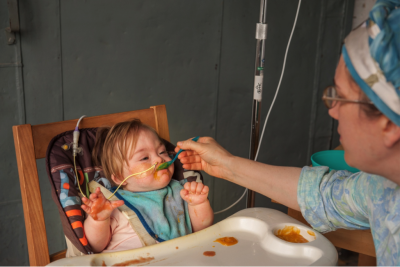
I often receive referrals from families who have been told their tube fed child has ‘oral aversion’. As discussed in an earlier blog, oral aversion refers to babies and children who do not want to put anything (or very limited things) in their mouth or sometimes even near their face. It may even be that they are happy to mouth a range of toys/non edible items but never mouth food/drinks. Perhaps they have a few favourite flavours they love licking off but will never take a bite into the biscuit.
We can only imagine the discomfort and fear of a baby/child being held down to have a naso-gastric tube inserted month after month. It’s no wonder they don’t want anyone coming near their face – I would treat everyone and everything with suspicion too. Everything except perhaps my favourite safe dummy or the exact same water bottle or those biscuits in a certain packet……things that I know are predictable and exact and will not change on me.
There’s also another very good reason for not wanting to put anything in their mouth – it’s called appetite and motivation. As seasoned eaters, we all know that when we’re hungry we will happily eat and when we’re not hungry we have no/limited motivation to eat – unless of course it’s our FAVOURITE food! Image everyday feeling like every meal is a ‘Christmas dinner’ – that feeling of ‘I’ve eaten too much and feel sick’. It makes you feel sleepy, not wanting to move, feeling like you may vomit at any given time. For a lot of children who are tube fed, this is how they feel day in, day out as they have no capacity to regulate their own appetite being tube fed ‘set’ amounts at ‘set’ times in the day – it’s no wonder they don’t want to learn to crawl or walk or babble and talk. It’s also a major factor in not wanting to mouth food and drinks. Something that is then diagnosed as ‘oral aversion’ – which to a degree it is – but the reason for it is a perfectly sensible decision by the baby/child that they do not feel hungry, they may in fact feel nauseous and do not want to put anything in their mouth except their VERY safe options.
So how do we help with their ‘oral aversion’? We give them a reason to want to mouth foods and drinks – the same reason that works for you and me. That’s right, we give them a bit of hunger and therefore motivation to have a little bit more water, or mouth a new food or take a bite into their ‘safe’ biscuit instead of just licking the flavour from it. Of course this level of hunger needs to be very closely monitored and supported by your team of medical and allied health therapists to carefully balance weight loss with a change in child eating/drinking behaviours. It also needs to occur in an environment with provides a natural model for eating and drinking (ie. family mealtimes) with limited external requests/prompts/pressure to ‘eat it’. For further details on one such program have a look at our Lively Eaters tube weaning therapy options.
So next time people refer to oral aversion in a tube fed child, put yourselves in their little shoes and think ‘if that were happening to me would I want to be eating and drinking too?’
Lively Feeding Therapist






Leave a Reply
Want to join the discussion?Feel free to contribute!